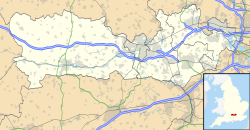
Back Windsor-kasteel Afrikaans Castiello de Windsor AN قلعة وندسور Arabic Castiellu de Windsor AST Vindzor sarayı Azerbaijani Віндзорскі замак Byelorussian Ўіндзарскі замак BE-X-OLD Уиндзорски замък Bulgarian Kastell Windsor Breton Castell de Windsor Catalan
| Windsor Castle | |
|---|---|
| Windsor, Berkshire, in England | |
 Round Tower and Upper Ward viewed from the Long Walk in Windsor Great Park | |
Location within Berkshire | |
| Coordinates | 51°29′0″N 00°36′15″W / 51.48333°N 0.60417°W |
| Type | Three bailey wards with a round keep |
| Site information | |
| Owner | King Charles III in right of the Crown |
| Operator | Royal Household |
| Open to the public | Limited access |
| Site history | |
| In use | Late 11th century – present |
| Materials | Bagshot Heath stone |
| Events | |
| Official name | Windsor Castle |
| Reference no. | 1006996 |
Listed Building – Grade I | |
| Official name | Windsor Castle Including All The Buildings Within The Walls |
| Designated | 2 October 1975 |
| Reference no. | 1117776 |
| Official name | The Royal Estate, Windsor: Windsor Castle and Home Park |
| Designated | 31 August 1999 |
| Reference no. | 1001434 |
Windsor Castle is a royal residence at Windsor in the English county of Berkshire. It is strongly associated with the English and succeeding British royal family, and embodies almost a millennium of architectural history.
The original castle was built in the 11th century, after the Norman invasion of England by William the Conqueror. Since the time of Henry I (who reigned 1100–1135), it has been used by the reigning monarch and is the longest-occupied palace in Europe. The castle's lavish early 19th-century state apartments were described by the art historian Hugh Roberts as "a superb and unrivalled sequence of rooms widely regarded as the finest and most complete expression of later Georgian taste".[1] Inside the castle walls is the 15th-century St George's Chapel, considered by the historian John Martin Robinson to be "one of the supreme achievements of English Perpendicular Gothic" design.[2]
Originally designed to project Norman dominance around the outskirts of London and oversee a strategically important part of the River Thames, Windsor Castle was built as a motte-and-bailey, with three wards surrounding a central mound. Gradually replaced with stone fortifications, the castle withstood a prolonged siege during the First Barons' War at the start of the 13th century. Henry III built a luxurious royal palace within the castle during the middle of the century, and Edward III went further, rebuilding the palace to make an even grander set of buildings in what would become "the most expensive secular building project of the entire Middle Ages in England".[3] Edward's core design lasted through the Tudor period, during which Henry VIII and Elizabeth I made increasing use of the castle as a royal court and centre for diplomatic entertainment.
Windsor Castle survived the tumultuous period of the English Civil War, when it was used as a military headquarters by Parliamentary forces and a prison for Charles I. At the Restoration of the monarchy in 1660, Charles II rebuilt much of Windsor Castle with the help of the architect Hugh May, creating a set of extravagant Baroque interiors. After a period of neglect during the 18th century, George III and George IV renovated and rebuilt Charles II's palace at colossal expense, producing the current design of the state apartments, full of Rococo, Gothic and Baroque furnishings. Queen Victoria made a few minor changes to the castle, which became the centre for royal entertainment for much of her reign. During the First World War, the historic estate inspired the naming of the royal House of Windsor. In the reign of George VI, it was used as a refuge by the royal family during the Luftwaffe bombing campaigns of the Second World War. An extensive restoration of several state rooms took place after the castle survived a fire in 1992. It is a popular tourist attraction, a venue for hosting state visits, and was the main residence of Elizabeth II from 2011 to 2022.[4]
- ^ Hugh Roberts, Options Report for Windsor Castle, cited Nicolson, p. 79.
- ^ Robinson, p. 27.
- ^ Cite error: The named reference
BrindleKerrP39was invoked but never defined (see the help page). - ^ Gordon Rayner (26 December 2015). "Buckingham Palace could become Queen's 'third home' as she opts for more time at Windsor and Balmoral". The Telegraph.
The Queen spent 10 more nights at Windsor Castle than Buckingham Palace in 2011, 35 in 2012, 59 in 2013, 52 in 2014, and 71 in 2015
© MMXXIII Rich X Search. We shall prevail. All rights reserved. Rich X Search
